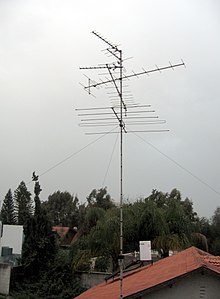Antenna (radio)
Electrical device / From Wikipedia, the free encyclopedia
Dear Wikiwand AI, let's keep it short by simply answering these key questions:
Can you list the top facts and stats about Aerial (radio)?
Summarize this article for a 10 years old
In radio engineering, an antenna (American English) or aerial (British English) is the interface between radio waves propagating through space and electric currents moving in metal conductors, used with a transmitter or receiver.[1] In transmission, a radio transmitter supplies an electric current to the antenna's terminals, and the antenna radiates the energy from the current as electromagnetic waves (radio waves). In reception, an antenna intercepts some of the power of a radio wave in order to produce an electric current at its terminals, that is applied to a receiver to be amplified. Antennas are essential components of all radio equipment.[2]
 | |
| Working principle | Electromagnetic radiation |
|---|---|
| Invented | Heinrich Hertz |
| First production | 1886 |
| Electronic symbol | |
.svg/100px-IEEE_315_Fundamental_Items_Symbols_(55).svg.png) .svg/100px-IEEE_315_Fundamental_Items_Symbols_(56).svg.png) | |
An antenna is an array of conductors (elements), electrically connected to the receiver or transmitter. Antennas can be designed to transmit and receive radio waves in all horizontal directions equally (omnidirectional antennas), or preferentially in a particular direction (directional, or high-gain, or "beam" antennas). An antenna may include components not connected to the transmitter, parabolic reflectors, horns, or parasitic elements, which serve to direct the radio waves into a beam or other desired radiation pattern. Strong directivity and good efficiency when transmitting are hard to achieve with antennas with dimensions that are much smaller than a half wavelength.
The first antennas were built in 1888 by German physicist Heinrich Hertz in his pioneering experiments to prove the existence of waves predicted by the electromagnetic theory of James Clerk Maxwell. Hertz placed dipole antennas at the focal point of parabolic reflectors for both transmitting and receiving.[3] Starting in 1895, Guglielmo Marconi began development of antennas practical for long-distance, wireless telegraphy, for which he received a Nobel Prize.[4]

